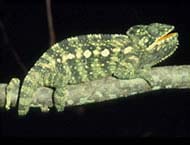Oral flex – Chameleon tongues have special muscle to haul in dinner

Unique muscles let chameleons fire at food. <br>© SPL <br>
Chameleons can reel in prey anywhere within two-and-a-half body lengths of their jaws. Their tongues can overcome even a bird’s weight and reluctance to be eaten. How? Muscles that are unique among backboned animals, researchers now reveal.
Anthony Herrel of the University of Antwerp, Belgium, and colleagues put crickets at different distances from the noses of two chameleon species, Chameleo calyptratus and Chameleo oustaletti. The tongues of these 12-cm-long reptiles pull at maximum strength on prey from 5-30 centimetres away, the team found.
Such versatility is beyond normal muscle: “it wouldn’t be able to pull back,” says Herrel. Muscle usually reaches its limit when its tiny pistons – filaments that slide back and forth over one another – are fully closed.
In the chameleons, the researchers discovered holes at the ends of each microscopic piston that allow the filaments to slide right through and carry on contracting. Insects have such ’supercontractile’ muscle, but this is a first in vertebrates.
The lizards’ muscle filaments also overlap more than usual when the tongue is fully extended (at six times its resting length). This increases the force that the muscle can exert. Finally, chameleon fire out, rather than poke out, their tongues. “Once it’s gone from the mouth it has its own trajectory – there’s very little control,” says Herrel.
“These observations go a long ways towards explaining how chameleons can retract their tongues,” agrees zoologist David Wake of the University of California, Berkeley. Wake has studied salamanders with a similar tongue-firing ability; he suspects that they might also have supercontractile muscle.
Too close for comfort
Chameleon tongues are less efficient with prey that is less than one-third of a body length away. A chameleon often retreats before firing out its tongue, to generate enough force to yank a meal from its perch.
Such specialization has evolved to capture large prey, Herrel believes. Chameleons sit and wait for food, so meals can be few and far between. “Any prey they see they need to be able to catch. If you only catch one prey item every few days, you want it to be as big as possible,” he says.
References
- Herrel, A., Meyers, J. J., Aerts, P. & Nishikawa, K. C. Functional implications of supercontracting muscle in the chameleon tongue retractors. Journal of Experimental Biology, 204, 3621 – 3627 , (2001)
Media Contact
All latest news from the category: Life Sciences and Chemistry
Articles and reports from the Life Sciences and chemistry area deal with applied and basic research into modern biology, chemistry and human medicine.
Valuable information can be found on a range of life sciences fields including bacteriology, biochemistry, bionics, bioinformatics, biophysics, biotechnology, genetics, geobotany, human biology, marine biology, microbiology, molecular biology, cellular biology, zoology, bioinorganic chemistry, microchemistry and environmental chemistry.
Newest articles
Faster, more energy-efficient way to manufacture an industrially important chemical
Zirconium combined with silicon nitride enhances the conversion of propane — present in natural gas — needed to create in-demand plastic, polypropylene. Polypropylene is a common type of plastic found…

Energy planning in Ghana as a role model for the world
Improving the resilience of energy systems in the Global South. What criteria should we use to better plan for resilient energy systems? How do socio-economic, technical and climate change related…

Artificial blood vessels could improve heart bypass outcomes
Artificial blood vessels could improve heart bypass outcomes. 3D-printed blood vessels, which closely mimic the properties of human veins, could transform the treatment of cardiovascular diseases. Strong, flexible, gel-like tubes…




















